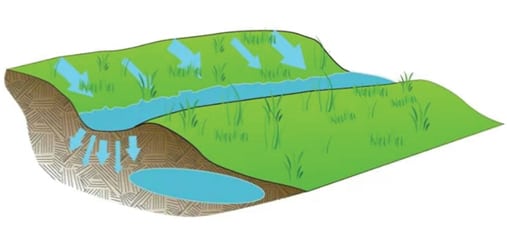What is flooding?
Flooding is when a massive amount of water is moved from one area to a new area that is normally dry or has little to no water. This is caused by rain, wind, or earthquakes causing the water levels to rise or move quickly to lower areas.
How can we prevent flooding?
Swale

A swale is a ditch like structure that allows the water to be moved to a new location using lower land. Here in the lower areas, the ground water is collected and absorbed back into the earth. Once absorbed, the water can be used by the surrounding plants or soaked into the existing aquifer under the swale.
Canal

A canal is used to redirect water, in a controlled way, back into a river. Canals can be man made with concrete and stone, or dug into the earth. They can also be called "flood control channels".
Wetlands

The wetlands are areas where water can be drained into. Wetlands are known for their below water level land and abundance of water. The land is always mushy or soft land that is able to absorb and hand extreme amounts of water. The land and the ecosystem thrive off the high amounts of water.
Stormwater Inlet

These inlets are a way for the water to move to a lower area and redirected to a new location. Using stormwater inlets, water is able to be moved off roads and other areas that may hold water. Water is collected under the ground and removed from the land where it was originally being collected.
Levee

Levees are raised walls made from concrete/ stone or with dirt to keep rising river water from filling surrounding areas. It is important for levees to be sturdy and effective to keep areas from being rushed with water when water levels rise.
Pervious Paved Roads

These roads are different than a normal road. These allow for water to be absorbed through the road, into the ground, and redirected into a new area. This is a great way to incorporate drainage in cities or towns by creating lots of areas for ground water to be drained.
Seawall

A seawall is created on the coast to keep large waves from the sea or ocean from flooding the nearby city. Many times cities on the coast will be heavily effected by large waves cause by wind or earthquakes, these walls help lower the impact by creating a barrier for the water.
Houses with Stilts

Some homes in areas with frequent flooding have stilts on the bottom of their homes. This keeps the water from rushing into the home by raising the house high above the ground. When the house is this high, the house is able to stay dry and safe from the rising waters. Many times these homes can be found on the coast.
Barrier Islands

Barrier islands are islands off the coast that keep waves caused by strong winds and earthquakes from crashing on the land. The islands are able to slow the speed of the waves. The barrier islands are also a great habitat for plants and animals.







